SU-57 (T48). Self-made lend-lease
Initially, this self-propelled gun was created in the United States by order of the British military, and was immediately intended to be supplied under the Lend-Lease program. From December 1942 to May 1943, the Diamond T Motor Car Company workshops left the 962 anti-tank self-propelled guns T48. By this time, the British military lost interest in the installation, and the USSR agreed to supply this vehicle, becoming the largest operator of PT-SAU T48, which received a new index SU-57. In total, the Soviet Union received 650 self-propelled guns of this type, the machines were actively used by Soviet troops as part of separate self-propelled artillery brigades and motorcycle battalions and armored reconnaissance companies.
Т48 from idea to implementation
Already at the very beginning of the Second World War, a mixed British-American Arms Commission began its work in the United States. The commission’s task was to draw up a program for the development, design, and production of various types and types of military equipment. One such model was the 57-mm self-propelled gun based on the chassis of the M3 semi-tracked armored personnel carrier common in the US Army. On the basis of M2 and M3 armored personnel carriers, American designers designed a large number of self-propelled anti-aircraft installations, self-propelled installations with different artillery weapons, as well as self-propelled mortars. Some of them were manufactured by the American industry in fairly large batches; the vehicle based on semi-tracked armored personnel carriers adopted the US Army and the armies of the allied anti-Hitler coalition countries.
The possibility of using the chassis of an armored personnel carrier as a base for different types of weapons was liked by the English military. They showed interest in creating a tank destroyer based on the M3, which would be armed with the British QF 6-pounder anti-tank gun. This British anti-tank 57-mm gun was actively used during World War II, both on the wheeled carriage and as the main armament of armored cars and tanks of the British army. The guns debuted in North Africa, this happened during the April 1942 battles. The gun was also appreciated by the Americans, who adopted the British cannon by slightly modernizing the 57-mm gun, in the US Army the artillery system was held under the designation М1.
An armor-piercing projectile of the specified weapon from a distance of 900 meters punched up to 73 mm armor steel, located at an angle of inclination 60 degrees. For the 1942 of the year, these were acceptable numbers, but with the advent of new German tanks and the strengthening of the frontal booking of existing combat vehicles, the effectiveness of the 57-mm British anti-tank gun only decreased. The choice of this particular instrument for installation on the M3 armored personnel carrier was due to the fact that the British wanted to get equipment that would be comparable in terms of weaponry to their own, for example, Valentine and Churchill tanks. It was the gun that was the main and only armament of anti-tank self-propelled guns on the chassis of a semi-tracked armored personnel carrier, but in the combat units of the machine they could also be equipped with machine guns for self-defense.
The first copy of the new anti-tank self-propelled entered for the test program at the Aberdeen Proving Ground in April 1942. Armed with an adapted version of the British 6-pound (57-mm) gun armored car received the designation T48 - 57 mm Gun Motor Carriage. Already in October 1942, the American order for a new self-propelled gun was canceled, in the United States drew attention to the new artillery systems caliber 75 mm and tracked self-propelled guns. At the same time, the release of the new ACS under the British order continued, mass production was launched in December 1942 of the year. The assembly of cars involved the company Diamond T Motor Company. However, the British also lost interest in the 1943, the new British self-propelled gun, who realized that it was ineffective against the newest German medium and heavy tanks, and in the UK developed a new 17-pound gun (76,2-mm) QF 17 pounder, which became the best anti-tank a tool of the allies, having received an armor-piercing piercing projectile with a separating tray.
As a result, the newly developed self-propelled gun was unnecessary to the main customers, the British received only 30 48 vehicles, and the Americans limited themselves to purchasing one anti-tank ACS, and they simply converted 282 ready-made self-propelled units back to M3-X1 armored vehicles. But the remaining 650 pieces found refuge in the USSR, the Soviet military showed interest in this car and ordered it as part of the lend-lease deliveries, the 241 car arrived in the Soviet Union in 1943, and 409 in 1944. However, only in the USSR, this anti-tank self-propelled gun was used for its intended purpose until the end of hostilities.
Design features SAU T48
The layout and appearance of the American self-propelled unit T48 were traditional for vehicles on such a base. Similar combat vehicles were available in the arsenal of the German army. The Germans also equipped their Sd Kfz 251 semi-tracked armored personnel carriers, known as the “Ganomag”, with artillery systems of various calibers: 37-mm anti-tank guns, short-barreled 75-mm guns, and by the end of the war and 75-mm long-barreled guns. Perhaps, having become acquainted with such combat vehicles at the front, the Soviet military decided to get their own counterpart, which led to the supply of 650 anti-tank SAU from the United States. In the Soviet Union, the car received a new designation SU-57. It is worth noting that our own armored personnel carriers in the USSR were not produced at all, therefore such equipment as a whole was of great interest for the Red Army.
The layout of the anti-tank self-propelled, built on the basis of the chassis of a semi-tracked armored personnel carrier, could be called a classic. The body of the self-propelled unit was distinguished by the simplicity of its forms and lines, the box-shaped design with vertically arranged sides and the stern walls was assembled using armor plates mounted on the frame from the corners. In the manufacture of self-propelled Т48 self-propelled guns were widely used commercial vehicles, mainly in the government and in the transmission. In front of the hull there was an engine hidden under an armored hood, behind it was the driver's cabin. At the same time, the American designers borrowed the hood part and cab from the Scout Car M3A1 wheeled reconnaissance armored vehicle that was supplied to the USSR and became the most massive BTR of the Red Army during the Second World War.
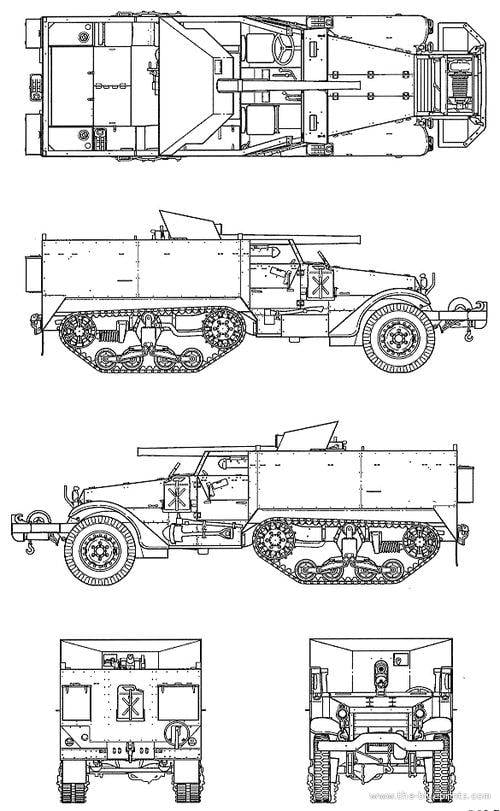
The self-propelled armored hull of the top was opened and was distinguished by anti-bullet armor, the thickness of the armor of the front hull sheets reached 13 mm, and in general, armored steel sheets with a thickness of 6,5 mm were used in the design of the combat vehicle. The 57-mm M1 American anti-tank gun, which received a semi-automatic vertical wedge gate, was installed in the open body. The gun was installed on the machine T-5, which was placed in front of the hull immediately behind the control compartment. The gun was installed in a shelter sheltered from above with precipitation with a box-shaped shield that defended the calculation from bullets and shell fragments; the ammunition load amounted to 99 shells. The gun had excellent horizontal pointing angles - 56 degrees, vertical tool pointing angles ranged from -5 to + 16 degrees. Three types of unitary shots were used for firing 57-mm donuts: two armor-piercing (thick-headed tracer and sharp-headed tracer) projectile and a fragmentation grenade. At a distance of 500 meters, the gun allowed the calculation to punch up to 81 mm of armor (at a meeting angle of 60 degrees).
The 6 carburetor 160AH engine, developing 147 hp power, was a true heart of the self-propelled unit; a bit of a weaker engine — International RED-450-B; developing 141 hp power — was installed on some machines. Weak firepower and lack of armor were compensated by good mobility and speed. With a combat weight of about 8 tons, this engine provided the machine with specific power at the level of 17,1 hp. per ton. When driving on the SAU highway, the T48 accelerated to the speed of 72 km / h, the power reserve of the self-propelled gun was estimated at 320 km.
The front wheels of the self-propelled unit were steering. In relation to each side, the Lend-Lev self-propelled crawler propulsion unit consisted of four double rubberized support rollers, the rollers were combined in pairs into two balance carts. On the part of the self-propelled guns in the front of the body was placed single drum winch. At the same time on some combat vehicles, the winch was changed to a buffer drum with a diameter of 310 mm. With such a device, the ACS patency increased, the presence of a drum facilitated the process of overcoming scaffolds, ditches and trenches up to the 1,8 meter wide.
Features of the combat use of the SU-57
The semi-tracked chassis and low weight provided the anti-tank self-propelled gun with good cross-country ability even on weak soils and snow. In this case, self-propelled gun predictably lost in control. When turning the front wheels, the combat vehicle was not always ready to get into the necessary direction of movement. In fairness it should be noted that similar shortcomings were inherent in the German semi-tracked armored personnel carriers. An open battle with the enemy’s tanks left the T48 self-propelled guns no chance of success. The use of ACS data from ambushes and pre-reinforced positions was considered effective. At the same time, approximately for such actions on the battlefield, a new combat vehicle was originally created.
By the 1943, the 57-mm gun had problems in fighting the new German Tiger and Panther tanks. At the same time she pierced the frontal armor of medium German tanks Pz.IV modifications G and H, it was possible to hit the Tiger or even the Ferdinand self-propelled gun, it was possible to board the hull. From a distance of 200 meters, one could try to hit the Tiger or the Panther directly in the forehead, but with such actions without a well-prepared and disguised position, it was a one-way ticket. It can be noted that with certain limitations, often very significant, the self-propelled gun still coped with its duties by actively participating in the battles on the Eastern Front.
If armor penetration made it possible to hit enemy equipment, albeit with a lot of restrictions, the impact of 57-mm guns on infantry and field fortifications was very weak. For the destruction of prepared defense lines and fortifications, such a weapon was not suitable. The power of 57-high-explosive high-explosive ordnance was clearly insufficient. The high-explosive shot of a similar gun weighed only 3,3 kg, and the mass of explosive was only 45 grams.
Lend-lease anti-tank self-propelled guns, which received the designation SU-57, were widely used in three separate self-propelled artillery brigades, each of which had 60-65 combat vehicles of this type. SU-57 were regular weapons for the 16, 19 and 22 (later 70 Guards) self-propelled artillery brigades, which fought in the 3, 1 and 4 of the Guards tank armies, respectively. In the Red Army, American self-propelled guns were also used by battalion and sub-divisional, in which case they were included in the composition of motorcycle battalions and separate reconnaissance companies on armored vehicles. In such units, ACS T48 were used particularly effectively, acting in its direct role - a semi-tracked armored personnel carrier with a reinforced armament complex.
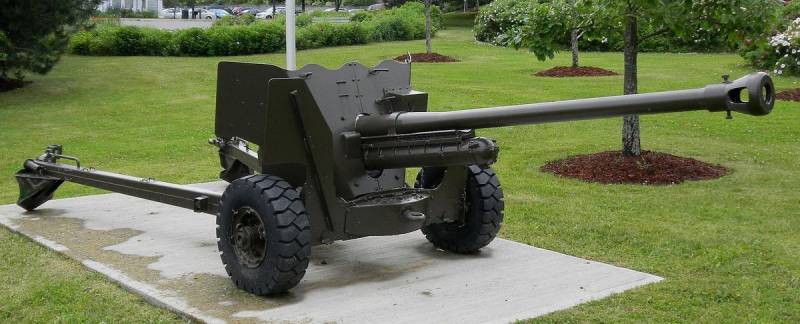
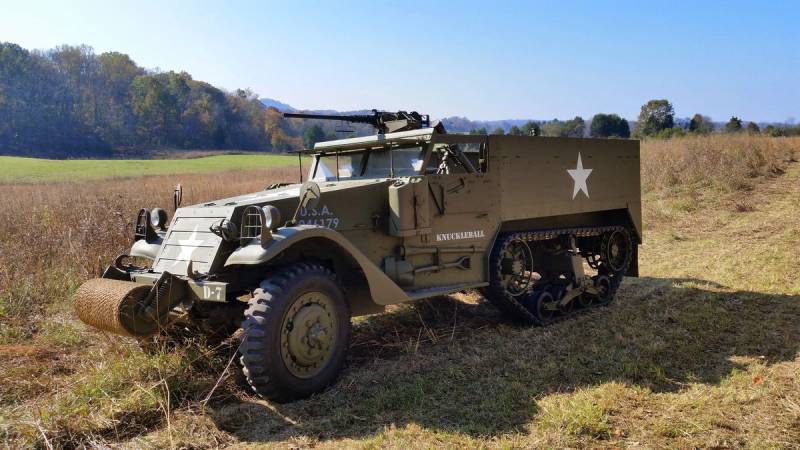
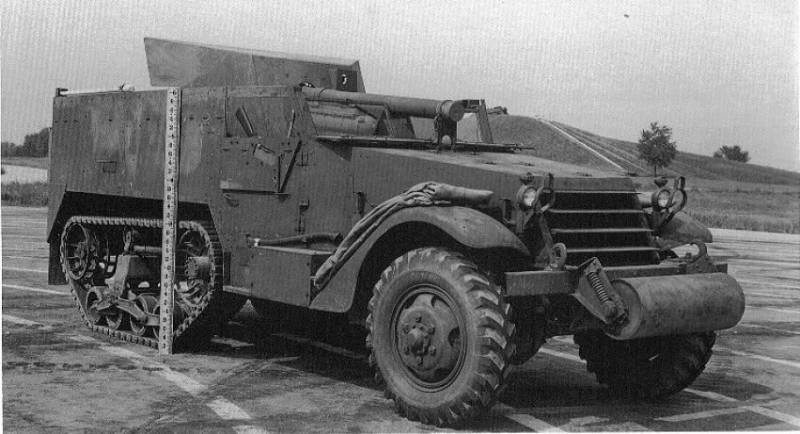
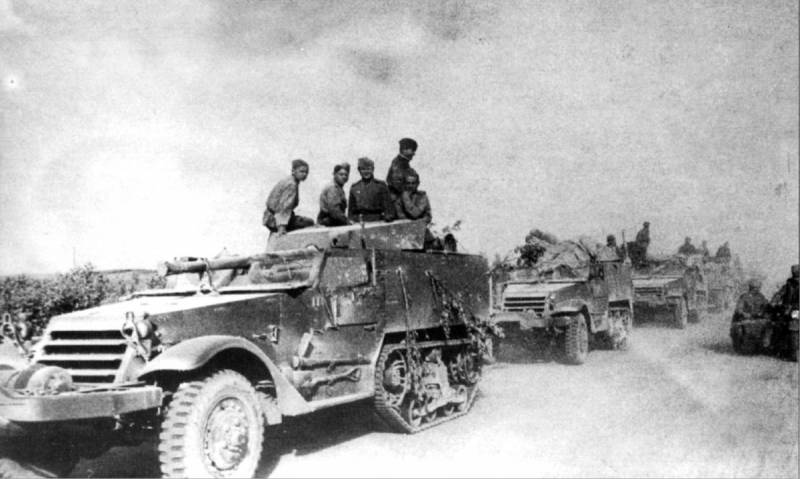
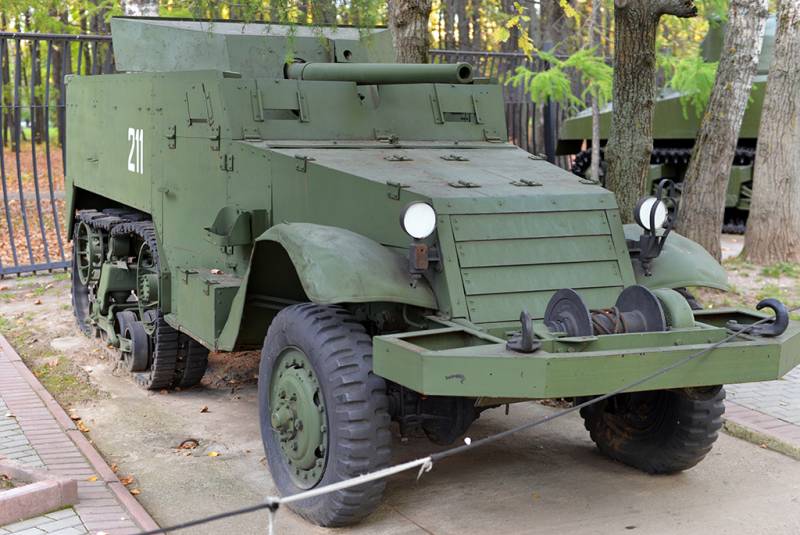
Information